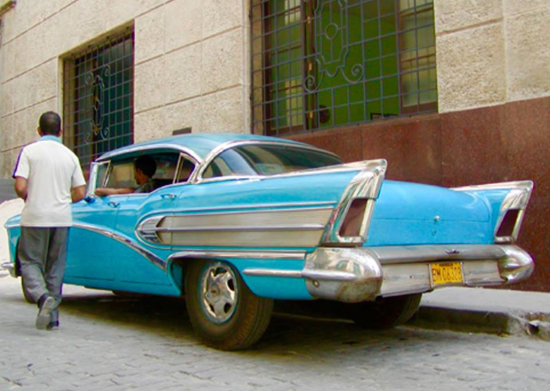
A Chevy Bel Air on the Street of Havana, Cuba
Since 1959, when Fidel Castro assumed power, the majority of Cubans have been prevented from importing foreign cars and parts. Being nostalgic doesn’t mean you’re old-school and sentimental, in Cuba it represents preservation of something necessary, creative, and awesome. For me, it also conjures up emotions, thoughts, and the wonderment of a stunning country semi-frozen in time. The cars that traverse from the ocean line to its peak are a rare attraction for visitors who venture to the land of tobacco, mambo, and rum.
Here is my story and what I discovered.
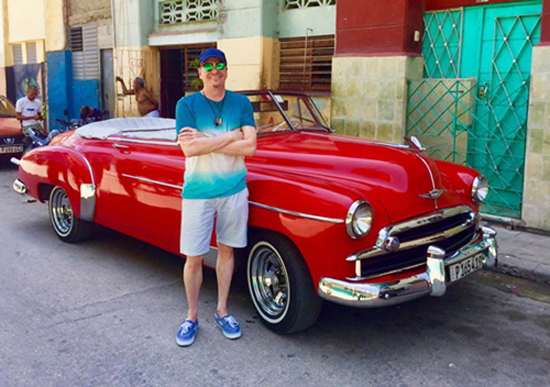
Writer P.K. Greenfield waiting for the driver of a 1950’s Chevrolet
My grandfather had a car from this era. His name was Fredrick but we called him Fritz, as he was the second husband of my grandmother — he wasn’t my blood abuelo (grandpa). Fritz was a cantankerous and aloof man, especially when around his wife’s grandkids; however, I vividly remember when he showed signs of passion and excitement. On Sundays, he would take us for rides in the countryside in his prized possession: a Chevrolet Bel Air, the color was aqua marine blue — both interior and exterior. This desire to see that same style of car recently lured me to Havana, Cuba.
When Fritz passed away, my family inherited his auto in stellar condition. My brother Tom drove it around the town and after he graduated college and moved away, I too received the auto to transport me to school. If only I could turn the clock back and had the support and know-how, his Bel Air would still be on the road.
Here is what I learned during my quest to rediscover the amazing cars from America that continue to majestically roll like caravans on the streets beyond La Habana Vieja (Old Havana).
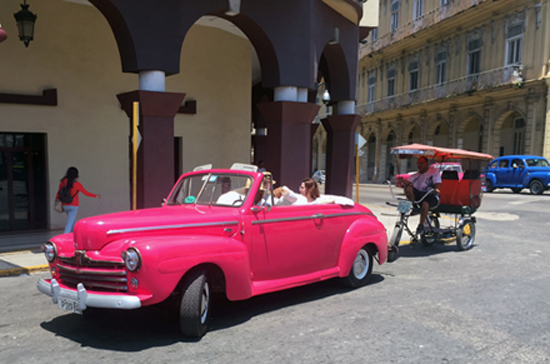
Classic American Cars roaming the streets of Old Havana
For the past 60+ years, Los Cubanos have successfully played the part of mechanical magicians, pulling components from old Fords, Chryslers, and Chevrolets, and even creating custom parts to keep their admirable vintage cars on the road. It’s nothing short of spectacular. Their pride and perseverance pays off with something breathtaking and very distinct in our large but closed world. The smell of diesel permeates the air as the cars rev their engines and are better equipped for this affordable petrol — a conservationist’s nightmare. But in my opinion, you pick your battles and rationing is still part of this society.
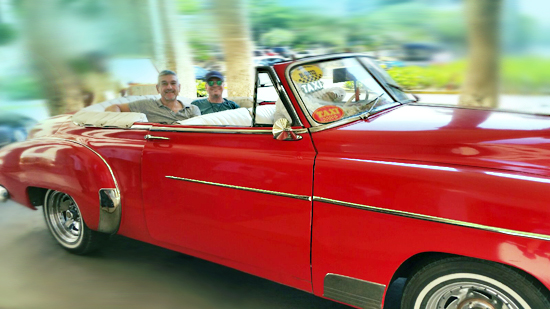
P.K. and Tony passing Hotel Nacional de Cuba
Our guide, Dani, and driver, Manolo, took my travel companion Tony and me on a remarkable excursion throughout the city, so we could observe and encounter the beauty of its architecture, the creations of local artisans, and the respectability and kindness of the city’s inhabitants — we were part of the people-to-people visit for Americans with the obligatory visa. I kept an eye peeled to see a car similar to my grandfather’s Bel Air as I enthralled to the things that I witnessed. This was not just a vacation, it was an educational experience. I’m practically fluent in Spanish, but many of the locals speak excellent English, especially when discussing the history of their car culture.
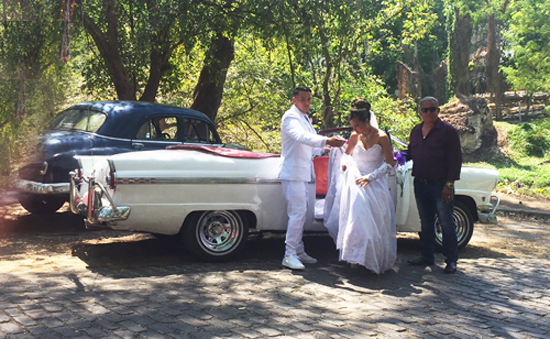
“La boda de dos países.” (A wedding)
Havana has a Parque Central (Central Park) similar to New York City but on a smaller scale, regardless, I recommend you take a ride through Parque Almendares. This lush park will make you forget that you are in a city. It’s a sort of raceway and showcase for the vintage cars to show off with special gatherings, camaraderie, and a celebration of all that is good on four wheels. Chances are, you will encounter a wedding or some event amongst the trees, river, and landscaping. Keep in mind that many of the vintage cars are not just for tourists. The locals use them for taxi rides and important celebrations.
This is part of their pride that I mentioned before.
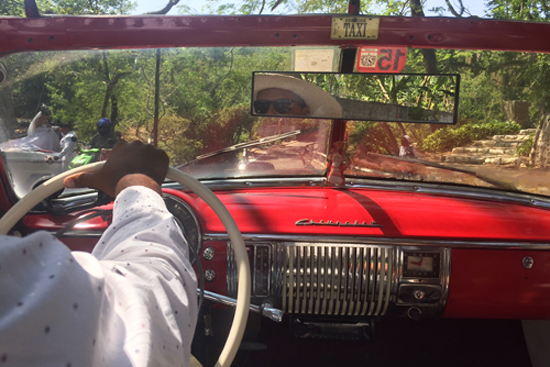
Manolo’s view from the road and mirror
With the chrome polished to near perfection, it all shines brilliantly in the Cuban sun, with the colors of the cars for the most part remaining close to their original color palette. I saw many autos on the road and parked on side streets that looked very similar to my grandfather’s style, but these models rolled off of the Detroit runway in different years. Many were two-tone teal with white hard tops. The interior of several of the cars featured a plastic sheath to protect the upholstery from the weather and wear-and-tear.
Our ride continued into neighborhoods for the rich, but mostly encompassed the impoverished. My thoughts immediately returned to my childhood memories, and while Manolo demonstrated the impressive sound system that he installed on this fire engine red 1950s Chevy, in my head I heard the song of my youth that Fritz and my grandmother would sing, “Buckle Up for Safety.” The tune was a marketing ploy/advertisement for the first cars that had mandatory safety belts installed.
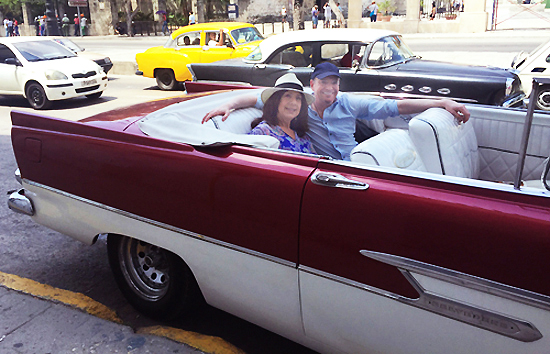
Writer P.K. with travel companion Trish
On the last day of this visit, we traveled to a popular market on the gran via Malecón, which is a popular avenue for locals and tourists, especially at night. Almacenes San José is just a short stroll from the port and well worth the pilgrimage. It’s a great way to see all of the cars rushing by like a “Greaser’s Race,” but with polished chrome, clear class, and non-derogatory pedal to the metal.
The artist market is located in a large two-story warehouse, a place featuring the work of hundreds of Cuban artists. Touristy? Perhaps. Worth a visit? Absolutely! Buy a T-shirt or something, but also talk with the people. Learn about their daily lives.
My friends and I did a little shopping to contribute to the local economy, then a man approached me and asked if we would like a ride. He knew I spoke Spanish, so I assumed word had traveled throughout the market, and he wasn’t taking advantage so much as trying to make a living. It was all on the up-and-up. We were tired of walking, so I said yes, and was expecting a regular taxi at the curb. He escorted us to this vintage car (above) and drove us back to our destination amid lively conversation.
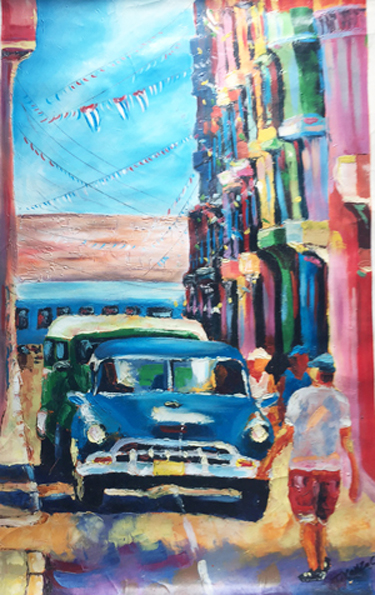
Abstract painting of the Chevrolet Bel Air in Acqua Marine Blue
In the end, I never did encounter the car that I was desperately seeking to find. I wanted to ride in a similar car once again, to remind me of those Sunday drives in the countryside of my youth. Instead, I found this painting by a local artist.
I will have it framed and placed on a wall in my New York City apartment. It will not only remind me of the halcyon days of my childhood, riding in my grandfather’s Chevy Bel Air with my family, but also the humble gratitude and appreciation I have for meeting the people of Havana, Cuba.
For tour information check out:
http://www.havanatourcompany.com
bookings@havanatourcompany.com
Read BNNYC Travel every month for insider tips and travel advice on and off the beaten path.

